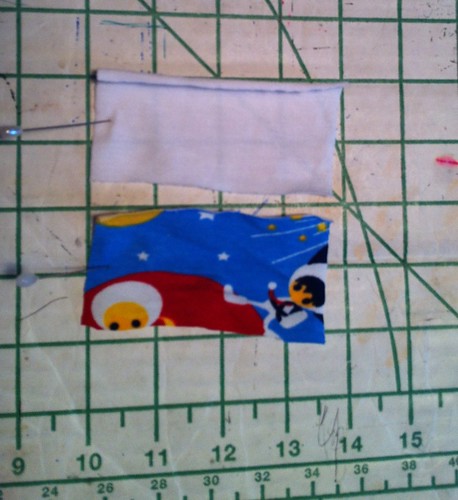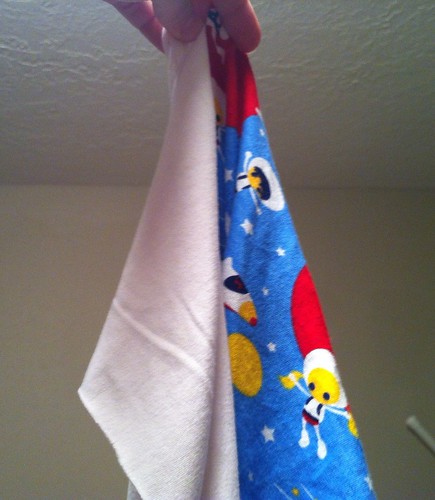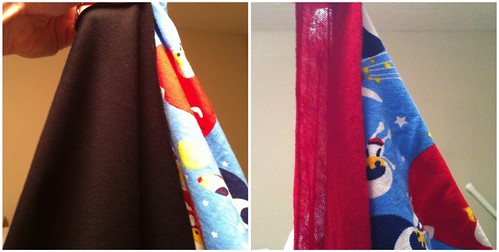Cap sleeve silk top and skinny jeans
Katie knows a crazy amount about loads of different fabrics, so she was an obvious choice to share her expertise on knits. So much so, I'm having to split her guest post into two parts! Today's installment is how to combine different knits into a single garment. Part two will be putting this knowledge into practise and showing some of the different ways to make precious hoarded fabric last for multiple projects. So here we go with Katie.........
How to successfully combine different knits into a single garment:
I am so excited that Amanda has asked me to guest post on her blog, and even more excited that we get to talk about my favorite sort of fabric - KNITS!!
My name is Katie and I blog over at Kadiddlehopper. I sew for myself, my 3 kids and on occasion, my hubby. We love the easy comfort of knit clothing of all varieties, and I love how fun knitted fabrics are to sew. Amanda was kind enough to send me a meter of the most amazing knit ever, and so I want to show you how to make a meter of a special fabric really go far. There are three strategies I tend to use:
The most important factors are amount of stretch and weight. If these two things are compatible, your project should go swimmingly.
Determining stretch:
Amount of stretch is really pretty easy to determine. Take a 4 inch long piece of your fabric and stretch it as far as it will go (without permanent distortion).
I stretch over a ruler so that I can measure how far and get a ratio that gives you the percent stretch.
For example, if my 4 inch long piece only stretches to 5 inches long, (ie one inch is gained) then I have a 25% (1/4) stretch. If you are comparing two pieces of fabric, you don't have to do the math though. Just stretch them together and make sure they are pretty close. They don't have to be exact, but if you try to stitch something with a ton of stretch to something fairly stable, the stretchy side may grow out of proportion to the non-stretchy side.
Determining weight: Weight can be a little harder to make out. Basically, the idea is that your don't want to sew something super thin to something massively thick. They don't have to be a perfect match, but they should at least behave the same way. I like to test this by draping my fabrics together.
I grab a corner of the two fabrics in one hand, and see how they fall. You want them to make the same size "cone" of fabric as they fall away from your hand.
See what I mean by the "cone"? The black double knit flares out as it falls, while the thin, red tissue knit almost falls straight down. When you compare them to the print, you can see that the way they fall is different. The white, which is the one I chose, forms a cone that is very similar to the print, which told me that they would sew well together.
One final, but still important, consideration is fiber content. In general, fabrics made from the same fiber will have similar properties, which will make them easier to work with together. You also want to consider washability. If you are sewing a cotton-lycra jersey that you intend to throw in the wash, you don't want to pair it with dry-clean-only silk jersey. And you do want to make sure that all of your fabrics have been pretreated so that they don't shrink. Imagine if just one shrank while the others didn't!! Catastrophe! Using fabrics of the same fiber type will help make this less of a problem as well.
________________________________________________________________A massive thanks to Katie for demystifying the process of pairing knits together for a single project. You guys won't believe what she managed to squeeze out of a metre! Mad skillz.
- Piecing: One of my favorite ways to make a special fabric really count is to piece it with solids or coordinating prints.
- Colorblocking: This is a hot trend right now, so don't limit yourselves to just kids clothes for this one. Give it a try yourself!
- Special Accents: Pockets, Patches and Applique. This method frequently uses small pieces, so you can use up every scrap of your precious fabric.
The most important factors are amount of stretch and weight. If these two things are compatible, your project should go swimmingly.
Determining stretch:
Amount of stretch is really pretty easy to determine. Take a 4 inch long piece of your fabric and stretch it as far as it will go (without permanent distortion).
I stretch over a ruler so that I can measure how far and get a ratio that gives you the percent stretch.
For example, if my 4 inch long piece only stretches to 5 inches long, (ie one inch is gained) then I have a 25% (1/4) stretch. If you are comparing two pieces of fabric, you don't have to do the math though. Just stretch them together and make sure they are pretty close. They don't have to be exact, but if you try to stitch something with a ton of stretch to something fairly stable, the stretchy side may grow out of proportion to the non-stretchy side.
Determining weight: Weight can be a little harder to make out. Basically, the idea is that your don't want to sew something super thin to something massively thick. They don't have to be a perfect match, but they should at least behave the same way. I like to test this by draping my fabrics together.
I grab a corner of the two fabrics in one hand, and see how they fall. You want them to make the same size "cone" of fabric as they fall away from your hand.
One final, but still important, consideration is fiber content. In general, fabrics made from the same fiber will have similar properties, which will make them easier to work with together. You also want to consider washability. If you are sewing a cotton-lycra jersey that you intend to throw in the wash, you don't want to pair it with dry-clean-only silk jersey. And you do want to make sure that all of your fabrics have been pretreated so that they don't shrink. Imagine if just one shrank while the others didn't!! Catastrophe! Using fabrics of the same fiber type will help make this less of a problem as well.
________________________________________________________________A massive thanks to Katie for demystifying the process of pairing knits together for a single project. You guys won't believe what she managed to squeeze out of a metre! Mad skillz.








Very, very interesting! Thanks Katie and Amanda!
ReplyDeleteI never knew about the CONE - thanks for doing a pic of different fabrics - fabulously illustrated! Can't wait for part 2...
ReplyDeleteVery very helpful, thank you. Any plans on selling plain knits in your shop?
ReplyDeleteDunno... maybe? If there was demand for it I would!
DeleteI find it hard to know what to buy when it comes to knits, especially in terms of quality. If you had a range of good quality co-ordinating knits then I would buy them, especially as they would help the prints go a bit further. Like with your new dress pattern I would probably use a patterned knit for the bodice and then plain for the sleeves and skirt.
ReplyDeleteI'm another cone ignorant person.*sheepishly hanging my head* Very interesting post!
ReplyDelete